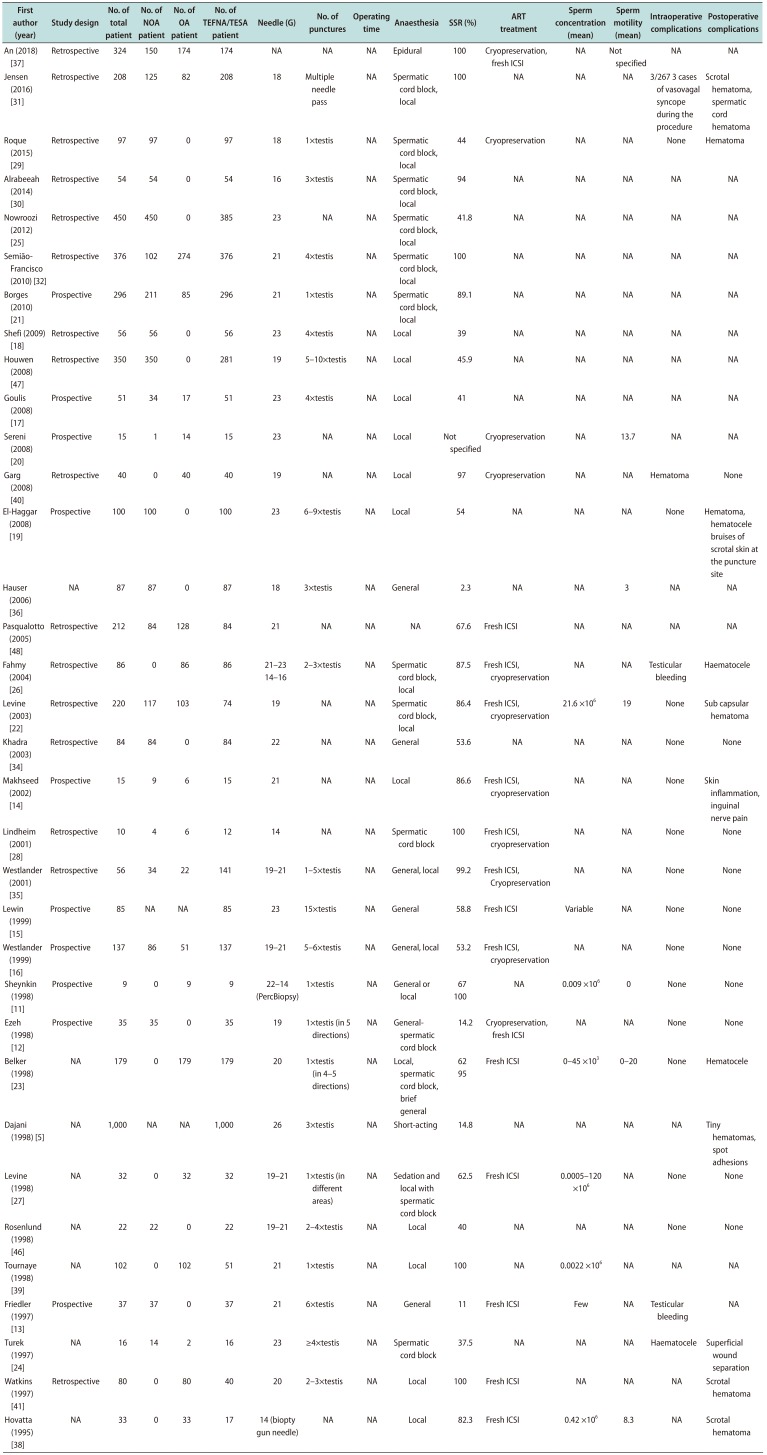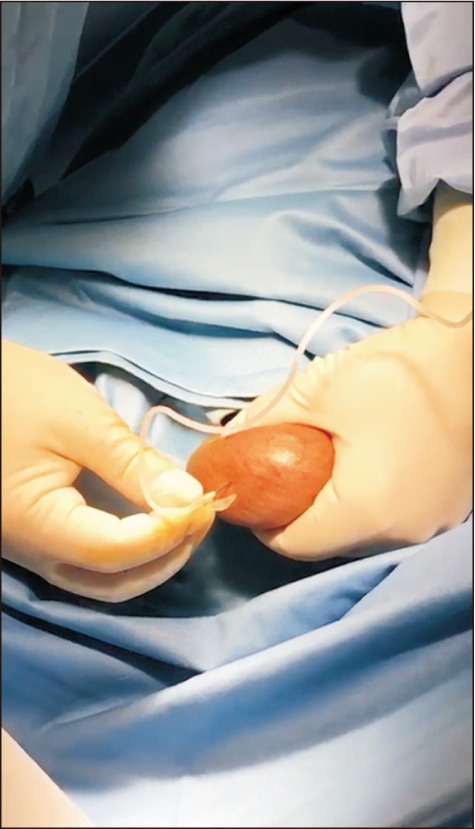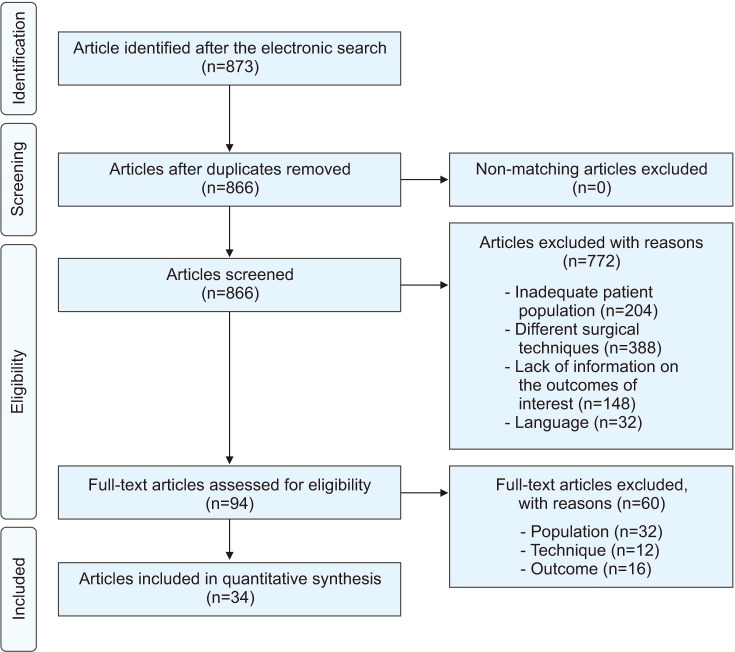1. AUA. The management of obstructive azoospermia: AUA best practice statement. Linthicum: American Urological Association Education and Research, Inc;2010.
2. Jarow JP, Espeland MA, Lipshultz LI. Evaluation of the azoospermic patient. J Urol. 1989; 142:62–65. PMID:
2499695.

3. Cohen MS, Frye S, Warner RS, Leiter E. Testicular needle biopsy in diagnosis of infertility. Urology. 1984; 24:439–442. PMID:
6495452.

4. Foresta C, Varotto A, Scandellari C. Assessment of testicular cytology by fine needle aspiration as a diagnostic parameter in the evaluation of the azoospermic subject. Fertil Steril. 1992; 57:858–865. PMID:
1555700.

5. Dajani YF, Kilani Z. Role of testicular fine needle aspiration in the diagnosis of azoospermia. Int J Androl. 1998; 21:295–300. PMID:
9805246.

6. Carpi A, Menchini Fabris F, Gorini I, Gaeta P, Romani R, Marchetti A. A percutaneous large-needle aspiration biopsy technique for histologic examination of the testis in infertile patients. Fertil Steril. 1999; 71:756–760. PMID:
10202893.

7. Steele EK, Ellis PK, Lewis SE, McClure N. Ultrasound, antisperm antibody, and hormone profiles after testicular Trucut biopsy. Fertil Steril. 2001; 75:423–428. PMID:
11172851.

8. Morey AF, MacDonald MF, Rozanski TA, Natarajan S, Thompson IM. Yield and efficacy of biopty gun testis needle biopsy. Urology. 1999; 53:604–607. PMID:
10096391.

9. Ron-El R, Strauss S, Friedler S, Strassburger D, Komarovsky D, Raziel A. Serial sonography and colour flow Doppler imaging following testicular and epididymal sperm extraction. Hum Reprod. 1998; 13:3390–3393. PMID:
9886520.

10. Belenky A, Avrech OM, Bachar GN, Zuckerman Z, Ben Rafael Z, Fisch B, et al. Ultrasound-guided testicular sperm aspiration in azoospermic patients: a new sperm retrieval method for intracytoplasmic sperm injection. J Clin Ultrasound. 2001; 29:339–343. PMID:
11424099.

11. Sheynkin YR, Ye Z, Menendez S, Liotta D, Veeck LL, Schlegel P. Controlled comparison of percutaneous and microsurgical sperm retrieval in men with obstructive azoospermia. Hum Reprod. 1998; 13:3086–3089. PMID:
9853861.

12. Ezeh UI, Moore HD, Cooke ID. A prospective study of multiple needle biopsies versus a single open biopsy for testicular sperm extraction in men with non-obstructive azoospermia. Hum Reprod. 1998; 13:3075–3080. PMID:
9853859.

13. Friedler S, Raziel A, Strassburger D, Soffer Y, Komarovsky D, Ron-El R. Testicular sperm retrieval by percutaneous fine needle sperm aspiration compared with testicular sperm extraction by open biopsy in men with non-obstructive azoospermia. Hum Reprod. 1997; 12:1488–1493. PMID:
9262283.

14. Makhseed M, Al Salem MH, Ahmed MA. Percutaneous testicular sperm aspiration and intracytoplasmic sperm injection in obstructive and non-obstructive azoospermia: an easy alternative to TESE and MESA. Urol Int. 2002; 68:86–90. PMID:
11834896.

15. Lewin A, Reubinoff B, Porat-Katz A, Weiss D, Eisenberg V, Arbel R, et al. Testicular fine needle aspiration: the alternative method for sperm retrieval in non-obstructive azoospermia. Hum Reprod. 1999; 14:1785–1790. PMID:
10402390.

16. Westlander G, Hamberger L, Hanson C, Lundin K, Nilsson L, Söderlund B, et al. Diagnostic epididymal and testicular sperm recovery and genetic aspects in azoospermic men. Hum Reprod. 1999; 14:118–122. PMID:
10374107.

17. Goulis DG, Polychronou P, Mikos T, Grimbizis G, Gerou S, Pavlidou V, et al. Serum inhibin-B and follicle stimulating hormone as predictors of the presence of sperm in testicular fine needle aspirate in men with azoospermia. Hormones (Athens). 2008; 7:140–147. PMID:
18477551.

18. Shefi S, Kaplan K, Turek PJ. Analysis of spermatogenesis in non-obstructive azoospermic and virtually azoospermic men with known testicular pathology. Reprod Biomed Online. 2009; 18:460–464. PMID:
19400985.

19. El-Haggar S, Mostafa T, Abdel Nasser T, Hany R, Abdel Hadi A. Fine needle aspiration vs. mTESE in non-obstructive azoospermia. Int J Androl. 2008; 31:595–601. PMID:
17822417.

20. Sereni E, Bonu MA, Fava L, Sciajno R, Serrao L, Preti S, et al. Freezing spermatozoa obtained by testicular fine needle aspiration: a new technique. Reprod Biomed Online. 2008; 16:89–95. PMID:
18252053.

21. Borges E Jr, Braga DP, Bonetti TC, Pasqualotto FF, Iaconelli A Jr. Predictive factors of repeat sperm aspiration success. Urology. 2010; 75:87–91. PMID:
19931128.

22. Levine LA, Dimitriou RJ, Fakouri B. Testicular and epididymal percutaneous sperm aspiration in men with either obstructive or nonobstructive azoospermia. Urology. 2003; 62:328–332. PMID:
12893345.

23. Belker AM, Sherins RJ, Dennison-Lagos L, Thorsell LP, Schulman JD. Percutaneous testicular sperm aspiration: a convenient and effective office procedure to retrieve sperm for in vitro fertilization with intracytoplasmic sperm injection. J Urol. 1998; 160:2058–2062. PMID:
9817323.

24. Turek PJ, Cha I, Ljung BM. Systematic fine-needle aspiration of the testis: correlation to biopsy and results of organ “mapping” for mature sperm in azoospermic men. Urology. 1997; 49:743–748. PMID:
9145981.

25. Nowroozi MR, Ahmadi H, Ayati M, Jamshidian H, Sirous A. Testicular fine-needle aspiration versus testicular open biopsy: comparable sperm retrieval rate in selected patients. Indian J Urol. 2012; 28:37–42. PMID:
22557715.

26. Fahmy I, Kamal A, Aboulghar M, Mansour R, Serour GI, Shamloul R. Percutaneous aspiration biopsy using an intravenous catheter for testicular sperm retrieval in patients with obstructive azoospermia. Reprod Biomed Online. 2004; 9:102–105. PMID:
15257830.

27. Levine LA, Lisek EW. Successful sperm retrieval by percutaneous epididymal and testicular sperm aspiration. J Urol. 1998; 159:437–440. PMID:
9649258.

28. Lindheim SR, Crumm K, Fisch H, Sauer MV. Testicular sperm aspiration (TESA) and its application in oocyte donation. Arch Androl. 2001; 46:211–215. PMID:
11339647.
29. Roque M, Valle M, Marques F, Sampaio M, Geber S. Intracytoplasmic sperm injection outcomes with cryopreserved testicular sperm aspiration samples. Andrologia. 2016; 48:252–256. PMID:
25998234.

30. Alrabeeah K, Yafi F, Flageole C, Phillips S, Wachter A, Bissonnette F, et al. Testicular sperm aspiration for nonazoospermic men: sperm retrieval and intracytoplasmic sperm injection outcomes. Urology. 2014; 84:1342–1346. PMID:
25432825.

31. Jensen CF, Ohl DA, Hiner MR, Fode M, Shah T, Smith GD, et al. Multiple needle-pass percutaneous testicular sperm aspiration as first-line treatment in azoospermic men. Andrology. 2016; 4:257–262. PMID:
26789006.

32. Semião-Francisco L, Braga DP, Figueira Rde C, Madaschi C, Pasqualotto FF, Iaconelli A Jr, et al. Assisted reproductive technology outcomes in azoospermic men: 10 years of experience with surgical sperm retrieval. Aging Male. 2010; 13:44–50. PMID:
20121463.
33. Li PS, Li SQ, Schlegel PN, Goldstein M. External spermatic sheath injection for vasal nerve block. Urology. 1992; 39:173–176. PMID:
1736514.

34. Khadra AA, Abdulhadi I, Ghunain S, Kilani Z. Efficiency of percutaneous testicular sperm aspiration as a mode of sperm collection for intracytoplasmic sperm injection in nonobstructive azoospermia. J Urol. 2003; 169:603–605. PMID:
12544317.

35. Westlander G, Rosenlund B, Söderlund B, Wood M, Bergh C. Sperm retrieval, fertilization, and pregnancy outcome in repeated testicular sperm aspiration. J Assist Reprod Genet. 2001; 18:171–177. PMID:
11411434.
36. Hauser R, Yogev L, Paz G, Yavetz H, Azem F, Lessing JB, et al. Comparison of efficacy of two techniques for testicular sperm retrieval in nonobstructive azoospermia: multifocal testicular sperm extraction versus multifocal testicular sperm aspiration. J Androl. 2006; 27:28–33. PMID:
16400074.

37. An G, Zou Z, Flannigan R, Liu J, Du H, Fu X, et al. Outcome of oocyte vitrification combined with microdissection testicular sperm extraction and aspiration for assisted reproduction in men. Med Sci Monit. 2018; 24:1379–1386. PMID:
29511156.

38. Hovatta O, Moilanen J, von Smitten K, Reima I. Testicular needle biopsy, open biopsy, epididymal aspiration and intracytoplasmic sperm injection in obstructive azoospermia. Hum Reprod. 1995; 10:2595–2599. PMID:
8567777.
39. Tournaye H, Clasen K, Aytoz A, Nagy Z, Van Steirteghem A, Devroey P. Fine needle aspiration versus open biopsy for testicular sperm recovery: a controlled study in azoospermic patients with normal spermatogenesis. Hum Reprod. 1998; 13:901–904. PMID:
9619545.

40. Garg T, LaRosa C, Strawn E, Robb P, Sandlow JI. Outcomes after testicular aspiration and testicular tissue cryopreservation for obstructive azoospermia and ejaculatory dysfunction. J Urol. 2008; 180:2577–2580. PMID:
18950806.

41. Watkins W, Nieto F, Bourne H, Wutthiphan B, Speirs A, Baker HW. Testicular and epididymal sperm in a microinjection program: methods of retrieval and results. Fertil Steril. 1997; 67:527–535. PMID:
9091342.

42. Martin HE, Ellis EB. Biopsy by needle puncture and aspiration. Ann Surg. 1930; 92:169–181. PMID:
17866350.

43. Carpi A, Nicolini A, Marchetti C, Iervasi G, Antonelli A, Carpi F. Percutaneous large-needle aspiration biopsy histology of palpable thyroid nodules: technical and diagnostic performance. Histopathology. 2007; 51:249–257. PMID:
17650219.

44. Donoso P, Tournaye H, Devroey P. Which is the best sperm retrieval technique for non-obstructive azoospermia? A systematic review. Hum Reprod Update. 2007; 13:539–549. PMID:
17895238.

45. Esteves SC, Miyaoka R, Orosz JE, Agarwal A. An update on sperm retrieval techniques for azoospermic males. Clinics (Sao Paulo). 2013; 68(Suppl 1):99–110. PMID:
23503959.

46. Rosenlund B, Kvist U, Plöen L, Rozell BL, Sjöblom P, Hillensjö T. A comparison between open and percutaneous needle biopsies in men with azoospermia. Hum Reprod. 1998; 13:1266–1271. PMID:
9647558.

47. Houwen J, Lundin K, Söderlund B, Bergh C, Kremer JA, Ekerhovd E. Efficacy of percutaneous needle aspiration and open biopsy for sperm retrieval in men with non-obstructive azoospermia. Acta Obstet Gynecol Scand. 2008; 87:1033–1038. PMID:
18850334.

48. Pasqualotto FF, Rossi LM, Guilherme P, Ortiz V, Iaconelli A Jr, Borges E Jr. Etiology-specific outcomes of intracytoplasmic sperm injection in azoospermic patients. Fertil Steril. 2005; 83:606–611. PMID:
15749488.

49. Schlegel PN, Su LM. Physiological consequences of testicular sperm extraction. Hum Reprod. 1997; 12:1688–1692. PMID:
9308794.

50. Chan PT, Schlegel PN. Nonobstructive azoospermia. Curr Opin Urol. 2000; 10:617–624. PMID:
11148736.

51. Colpi GM, Pozza D. Diagnosing male infertility: new possibilities and limits. Basel: Karger;1992. p. 130–135.
52. Bonyadi MR, Madaen SK, Saghafi M. Effects of varicocelectomy on anti-sperm antibody in patients with varicocele. J Reprod Infertil. 2013; 14:73–78. PMID:
23926568.







 PDF
PDF ePub
ePub Citation
Citation Print
Print





 XML Download
XML Download